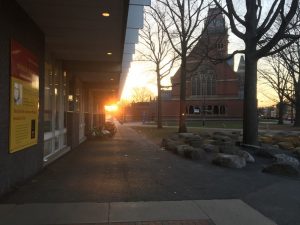




I have always loved photography. The ability to capture different moments in my life appeals to my nostalgia and also gives me the space to reflect upon where I have been and where I am going. As each day passes the meaning in each picture becomes stronger; within it is emotion that words often fail to capture.
Humans tend to view life as a journey from point A to point B. We begin at birth and end at death, two points everyone shares and no one can escape. The journey in between is life, where we learn who we are, what we desire for ourselves and others, and what we want to leave behind for other individuals lucky enough to go through this brief journey.
Like everything in life religion is viewed in this singular manner. An individual begins as immoral and unaware and ends up more ethical and wise. This traditional view of religion can be scene in the framing of all these photographs, the photographer takes the photo towards a vanishing point what they could have ventured towards, if they were feeling so adventurous. Around the singular path are distractions: stone, mud, trees, bushes, shopping malls, buildings, etc., but nonetheless, the path is clear to the viewer.
However, viewing both life and religion in this singular perspective is quite ignorant. All of these photos like different lives and sects of Islam begin and end at different places and exist within different contexts. No one is better than the other, each is unique in their perspectives and the surroundings in which they took root.
This idea is an essential part of the course’s cultural studies approach, which uses ethnic, social, economic, and other considerations to understand religion. Everyone can define Islam for themselves, but no one person can define Islam for anyone but themselves. A Muslim might ascribe to one sect over others, but even within that sect, their relationship to the world and God is not solely limited to the ideology of their religion. We saw these ideas in action with the modern Islamic revival movements through which rose different interpretations of what Islam is. For some, Islam should be interpreted as it was in the past, but for others past interpretations are either too “liberal” or too “conservative” and dated. In the arts we saw the different interpretations of Islam through the Sufi Rockstar in Pakistan. For orthodox mullahs, the Sufi Rockstar’s music was un-Islamic and therefore should be totally rejected, while for thousands of young individuals, it was a way to connect with the Qawali music and faith of their ancestors.
These ideas were explored in the course during Week 8 when we examined various music traditions in Islam and why some considered music “halal” or too secular.
Categories: